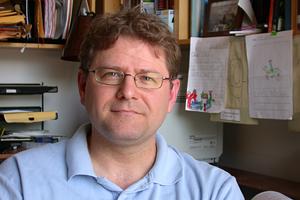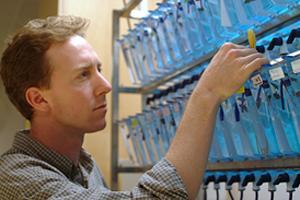August 1, 2011
Four faculty members at Amherst College—John-Paul Baird, Ethan Clotfelter, Michael Hood and Katharine Sims—have recently been awarded sizable research grants from the National Science Foundation and the National Institutes of Health.
The four professors will use their grants to work with students to continue researching brain circuitry, fish evolution, plant disease and environmental conservation, respectively. Below are brief descriptions of the grants and the research that will be supported.
Understanding Eating and the Brain
 |
John-Paul Baird, a professor of psychology and neuroscience, will continue his laboratory research to better understand how mechanisms inside the brain influence impulses related to eating, such as feeling hungry or full, with his sixth grant from the National Institutes of Health.
It turns out that understanding the brain circuitry that’s connected to food consumption is surprisingly complex. Yet it’s immensely important in an era of rising obesity rates and other metabolic disorders that contribute to diseases such as hypertension, stroke, diabetes and heart disease.
“Elucidating the neural systems that control feeding is a fundamental goal for clinical as well as basic science,” Baird said. “This grant will continue to explore the role of the brainstem as a site of feeding-related hypothalamic neuropeptide action. It will thus contribute to basic research that could help to identify potential pharmacological therapeutic targets.”
The three-year, $450,000 grant will allow Baird to continue to work closely with undergraduate students, several of whom have been his co-authors on articles that were published in peer-reviewed scientific journals and who have gone on to medical school or doctoral programs at universities such as Stanford, Texas, UC Berkeley, Indiana, Pennsylvania and Emory. (Three such journal articles can be found at www.ncbi.nlm.nih.gov/pubmed/21734020, www.ncbi.nlm.nih.gov/pubmed/19008313 and www.ncbi.nlm.nih.gov/pubmed/17989139.)
In fact, the professor’s research and mentoring has been so successful that his grant is one of a very few that this particular NIH institute has awarded in recent years specifically to allow for the training of undergraduates and to encourage them to pursue careers in science or medicine.
“At least 20 Amherst students have contributed to research for this grant project since 2005, and I’ve tried to integrate them in every aspect of it, from collecting the data all the way to publishing the manuscripts in scientific journals,” Baird said. “I've really used the university model of a graduate student, and that’s been very successful here.”
Studying fish behavior
 |
Biology professor Ethan Clotfelter will be studying physiological tradeoffs made by female convict cichlids (Amatitlania nigrofasciata), a tropical fish species, native to Central America, in which the females are more brightly colored than males.
Their bright colors are relatively rare for female fish and are derived from carotenoid pigments, which the fish must obtain through their diets.
“What drew us to this species is that females have a complicated set of decisions to make about the carotenoid pigments that make them colorful but also play important roles in reducing oxidative stress, supporting the immune system and imparting these qualities to their offspring in egg yolk,” Clotfelter said.
“We’re interested in getting a better handle on all these choices these fish have to make, and we think our work has broader applicability in how animals make choices in general and in how physiological systems evolve,” he added.
Clotfelter said his grants, $310,000 from the National Science Foundation and $29,000 in additional funding from the College’s Faculty Research Award Program, will be used to train students in pigment and immune analysis. It will also support research trips with students to Nicaragua and Costa Rica to study convict cichlids in their native habitats.
Anther-Smut fungus explored
 |
In collaboration with researchers at the University of Virginia and the Centro di Floristica—Parco Naturale Alta Valle Pesio in Italy, biology professor Michael Hood and a team of Amherst undergraduates will use part of a $1.3 million, five-year National Science Foundation grant to continue Hood’s research on a model infectious disease, the harmless-to-humans anther-smut caused by the fungus Microbotryum violaceum. The goal of the study, according to Hood, is to give scientists a better understanding of how infectious diseases progress among all kinds of organisms and across a wide range of geographic scales.
“In the past, I’ve studied the distribution of anther-smut disease on a global level,” he explained. “But now our team is asking how this highly specialized pathogen influences the distribution of its hosts.” He noted that, in addition to subsidizing his group’s research, Amherst’s $350,000 portion of the NSF award will fund a field course in disease ecology for the participating students, which “will provide a unique educational experience nested within a major research project.”
Hood and three undergraduates will begin the project this summer at an alpine refuge in the Ligurian Alps of northwestern Italy. (While some of his team’s experimental work will be done in the Amherst campus greenhouse and his lab in the McGuire Life Sciences building, the bulk of their field research will be conducted in the alpine populations.) The region is ideal for studying disease and host distributions, he said, because it is a global hot spot for diversity of the wild carnations that are affected by anther-smut. The area’s traversable valley systems also make it possible to examine natural disease occurrence across a range of environmental conditions.
Hood explained that he is especially interested in the geographic distribution of the plants and how they interact with anther-smut disease. There are certain environments where the wild carnations ought to be found, he said, but anther-smut disease may be making the environments uninhabitable. As such, the fungus may be determining the margins, or the edges, of their hosts’ geographic distributions.
“Particularly in periods of climate change, the habitats that organisms occupy are being altered and encroached upon by other species,” Hood explained. “The wild carnations—which colonize the mountains within certain altitudinal boundaries—may have to migrate to higher, cooler elevations as the climate warms and compete with other species that occur there. So we are curious about what role infectious diseases play in shaping these changing ecosystems.”
And what the group finds, he said, could have broader implications beyond the anther-smut. “Understanding the forces that influence species distributions is essential for predicting the impact of climate change on biodiversity.”
Environmental Conservation in Mexico
 |
Katharine Sims, an assistant professor in economics and environmental studies, has received a $100,401 National Science Foundation grant to support a study of the environmental and socioeconomic impacts of Mexico’s national payments for environmental services program.
“Mexico’s program is an example of an innovative type of environmental conservation policy that tries to align the incentives of landholders with those of society as a whole,” Sims said. Under the program, landowners receive payments for their stewardship of forests, which provide “services” to society, including watershed protection and storage of carbon.
She and her student researchers—Leah Fine ’12, Caroline Stedman ’12 and Alejandro Sucre ’13—are part of an interdisciplinary team that includes researchers from the University of Wisconsin-Madison, Duke University and the Mexican National Forestry Commission and has also received financial support from the International Initiative for Impact Evaluation.
This summer, the team is collecting new survey data from households and communities in Mexico. “We are trying to assess a range of different ways in which the program might have had an impact on household or community behavior,” Sims said. Sucre traveled to Mexico in late May to help launch the survey, and he and Stedman are working on campus this summer with the data it has begun to yield.
One of the questions that Sims’ team aims to analyze is how the program’s overall efficacy might be affected by “slippage” of deforestation to other locations.
“The program aims to change decisions about deforestation by making conservation more profitable,” Sims said. “But this can lead to other changes in household behavior or in market prices, which can make it more profitable to deforest somewhere else. The survey data will help us to understand how households and communities are making these decisions.”
Incentive-based conservation programs such as Mexico’s are likely to expand dramatically under proposed international agreements to reduce carbon emissions, but Sims’s research project is one of relatively few yet to study how the programs work in developing, rather than industrialized, countries. “Our hope,” she said, “is that our results will help future policymakers best target scarce funds for conservation.”